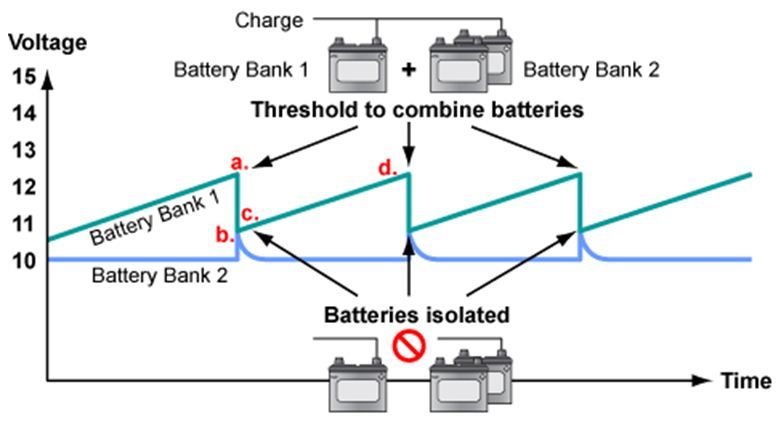Have you heard your battery isolator click on and off too often and wondered why ?
I have explained this below and also tips on how to prevent this from happening.
Preventing Cycling in Battery Combiners, Voltage Sensitive Relays, and Automatic Charging Relays
(Extracts from Blue Sea Systems and ABR-
The primary functions of battery combiners, which include voltage sensitive relays and automatic charging relays (VSR and ACR), are:
Combine battery banks so that they can share the output of a single charging source such as an alternator or external battery charger
Automatically isolate battery banks to prevent discharging of the Start battery bank
In some applications, as soon as a battery combiner closes to combine battery banks, it may immediately reopen because the load demand put on the charging source exceeds its output. This combining (closing) and isolating (opening) process may repeat over and over, it will cycle repetitively until the demand is below the threshold of the battery combiner.
A Closer Look at Cycling
When a battery combiner senses a charge on a battery bank ("a" in diagram), it combines the battery banks to share the charge. If the combined battery banks require more current than the charger, system or wiring can deliver, there will be a net discharge in the system ("b" in diagram). The combiner will detect that the voltage has fallen and isolate the battery banks ("c" in diagram). As soon as the two battery banks are isolated, the voltage will rise again and the combiner will cycle back on and combine battery banks ("d" in diagram). This cycling will repeat over and over.


Charging Source Cycling
This condition isn't dangerous, but the secondary battery bank (battery bank 2 in the diagram above) may eventually discharge because it is not receiving a charge, and the combiner may be subject to excess wear .
Causes of Cycling
There are three common causes of repetitive cycling:
A load on the secondary battery bank requires more current than the charging source can provide.
The secondary battery bank may be very large and/or deeply discharged. This is common when the charging source is connected to the Start battery bank and there is a large auxiliary battery bank supplying power to appliances.
Combiner sensing is connected at a point in the circuit that is far from the charged battery bank or charging source. When the combiner connects the battery banks, there is a relatively high current flowing through the wires resulting in voltage drop that reduces the apparent voltage at the combiner.
Preventing Cycling
There are easy ways to prevent repetitive cycling:
Make sure the battery combiner is mounted close to the source of charge / main battery.
Keep the auxiliary battery bank charged by monitoring the system and charging more often if necessary. It is best to keep the auxiliary battery above 40 percent state of charge which means keeping the voltage above 12.1 volts.
Good installation practices use good quality cable 10mm2 cable is a minimum requirement for one auxiliary battery.



